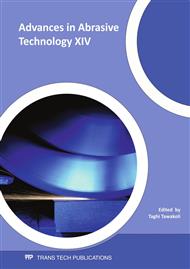[1]
LR-K. Gillespie: Deburring and edge finishing handbook, ASME Press, New York, (1989).
Google Scholar
[2]
H–M. Beier: Handbuch Entgrattechnik, Carl Hauser Verlag, München, (1999).
Google Scholar
[3]
W. König: Köszörülés, dörzsköszörülés, tükrösítés (Grinding, honing, lapping), Budapest, Műszaki Könyvkiadó, (1983).
Google Scholar
[4]
T. Shinmura, K. Takazawa, E. Hatano: Study on Magnetic-Abrasive Process. Bull. Japan Soc. of Prec. Eng., Vol. 19, No 3, 1985., pp.218-220.
Google Scholar
[5]
J. J. Warnecke, H. J. Ruben, K. Przyklenk: Magnetoabrasives Feinschleifen. Werkstattstechnik, No. 11. 1986., pp.677-681.
Google Scholar
[6]
J. Kodácsy, A. Szabó, J. Danyi: The State of the Art and Recent Results of Magnetism-Aided Surface Improving and Edge Finishing Processes. 10th International Research/Expert Conference, Lloret de Mar/Barcelona, 2006., pp.85-88.
Google Scholar
[7]
D. Korn: Deburr Small Parts Stainless Spins. MMS Online Modern Machine Shop, 2006/09.
Google Scholar
[8]
Kodácsy J., Szabó A.: Magnetic Aided Deburring and Edge Finishing. 2nd Asia-Pacific Forum on Precision Surface Finishing and Deburring Technology, Soeul 2002., pp.238-242.
Google Scholar
[9]
E. Wantuch, J. Gawlik: The Application of Magnetic Field and Process-Induced Heat Streams in the Shaping of Surface Layer Features. Zagogmenia Maszyn, Vol.: 29., (1994).
Google Scholar
[10]
A. B. Khairy: Aspect of Surface and Finish by Magneto-abrasive Particles. Journal of Materials Processing Technology, 116, (2001).
Google Scholar
[11]
Y. M. Baron, S. L. Ko, J. I. Pack: Characterization of the Magnetic Abrasive Finishing Method and Its Application to Deburring. Engineering Materials, Vols.: 291-292, 2005., pp.291-296.
DOI: 10.4028/www.scientific.net/kem.291-292.291
Google Scholar
[12]
S. Yiu, T. Shinmura: A Comparative Study: Polishing Characteristic and Its Mechanism of Three Vibration Modes in Vibration-Assisted Magnetic Abrasive Polishing. International Journal of Machine Tools & Manufacture, 44, 2004., pp.383-390.
DOI: 10.1016/j.ijmachtools.2003.10.002
Google Scholar
[13]
J. Kodácsy: Apparatus for Cleaning, Deburring and Polishing Parts in Magnetic Field. 7th International Conference on Deburring and Surface Finishing, UC Berkeley (USA), 2004., pp.351-354.
Google Scholar
[14]
European Patent, No.: 1545834/(2006).
Google Scholar


